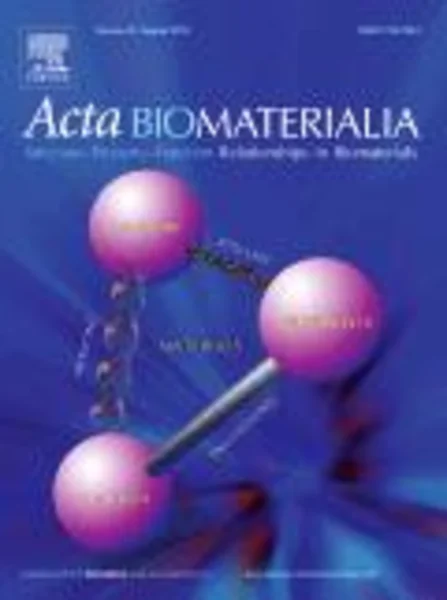-
bfgf-containing electrospun gelatin scaffolds with controlled nano-architectural features for directed angiogenesis
جزئیات بیشتر مقاله- تاریخ ارائه: 1392/01/01
- تاریخ انتشار در تی پی بین: 1392/01/01
- تعداد بازدید: 959
- تعداد پرسش و پاسخ ها: 0
- شماره تماس دبیرخانه رویداد: -
current therapeutic angiogenesis strategies are focused on the development of biologically responsive scaffolds that can deliver multiple angiogenic cytokines and/or cells in ischemic regions. herein, we report on a novel electrospinning approach to fabricate cytokine-containing nanofibrous scaffolds with tunable architecture to promote angiogenesis. fiber diameter and uniformity were controlled by varying the concentration of the polymeric (i.e. gelatin) solution, the feed rate, needle to collector distance, and electric field potential between the collector plate and injection needle. scaffold fiber orientation (random vs. aligned) was achieved by alternating the polarity of two parallel electrodes placed on the collector plate thus dictating fiber deposition patterns. basic fibroblast growth factor (bfgf) was physically immobilized within the gelatin scaffolds at variable concentrations and human umbilical vein endothelial cells (huvec) were seeded on the top of the scaffolds. cell proliferation and migration was assessed as a function of growth factor loading and scaffold architecture. huvecs successfully adhered onto gelatin b scaffolds and cell proliferation was directly proportional to the loading concentrations of the growth factor (0–100 bfgf ng/ml). fiber orientation had a pronounced effect on cell morphology and orientation. cells were spread along the fibers of the electrospun scaffolds with the aligned orientation and developed a spindle-like morphology parallel to the scaffold’s fibers. in contrast, cells seeded onto the scaffolds with random fiber orientation, did not demonstrate any directionality and appeared to have a rounder shape. capillary formation (i.e. sprouts length and number of sprouts per bead), assessed in a 3-d in vitro angiogenesis assay, was a function of bfgf loading concentration (0 ng, 50 ng and 100 ng per scaffold) for both types of electrospun scaffolds (i.e. with aligned or random fiber orientation).
مقالات جدیدترین رویدادها
-
استفاده از تحلیل اهمیت-عملکرد در ارائه الگوی مدیریت خلاقیت سازمانی و ارائه راهکار جهت بهبود
-
بررسی تاثیر ارزش وجوه نقد مازاد بر ساختار سرمایه شرکت های پذیرفته شده در بورس اوراق بهادار تهران
-
بررسی تأثیر سطح افشای ریسک بر قرارداد بدهی شرکت های پذیرفته شده در بورس اوراق بهادار تهران
-
بررسی تأثیر رتبه بندی اعتباری مبتنی بر مدل امتیاز بازار نوظهور بر نقد شوندگی سهام با تأکید بر خصوصی سازی شرکت ها
-
تأثیر آمیخته بازاریابی پوشاک ایرانی بر تصویر ذهنی مشتری پوشاک ایرانی (هاکوپیان)
-
اثر کرایوتراپی بر لیکن پلان اروزیو مخاط دهان
-
قطعه بندی سیگنال فنوکاردیوگرام سالم و بیمار با استفاده از پوش همومورفیک تطبیقی
-
اولین همایش ملی گردشگری، جغرافیا و محیط زیست پایدار گردشگری و نقش آن در محیط زیست پایدار
-
سرطان معده
-
single grain osl dating of miam qanat system in ne iran and slip rate determination of dashtebayaze fault
مقالات جدیدترین ژورنال ها
-
مدیریت و بررسی افسردگی دانش آموزان دختر مقطع متوسطه دوم در دروان کرونا در شهرستان دزفول
-
مدیریت و بررسی خرد سیاسی در اندیشه ی فردوسی در ادب ایران
-
واکاوی و مدیریت توصیفی قلمدان(جاکلیدی)ضریح در موزه آستان قدس رضوی
-
بررسی تاثیر خلاقیت، دانش و انگیزه کارکنان بر پیشنهادات نوآورانه کارکنان ( مورد مطالعه: هتل های 3 و 4 ستاره استان کرمان)
-
بررسی تاثیر کیفیت سیستم های اطلاعاتی بر تصمیم گیری موفق در شرکتهای تولیدی استان اصفهان (مورد مطالعه: مدیران شرکتهای تولیدی استان اصفهان)
-
بررسی عوامل گرایش انسان به آرزوهای طولانی از دیدگاه اخلاق اسلامی
-
مطالعه جایگاه ریاضیات در قرآن کریم و به کارگیری آن در آموزش ریاضی مدرسه ای
-
بررسی و نقد ارای صادره هیئت عمومی دیوان عدالت اداری در سال های اخیر
-
بهبود زمان پاسخ بازی های ابری با کمک الگوریتم های لایه برداری و پیش بینی حرکت
-
بررسی و تحلیل مدیریت بحران در هنگام وقوع زلزله در مدارس ایران




سوال خود را در مورد این مقاله مطرح نمایید :